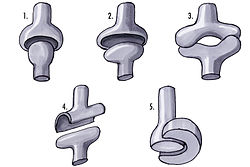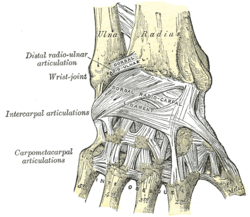Saddle joint
| Saddle Joint | |
|---|---|
 1: Ball and socket joint; 2: Condyloid joint (Ellipsoid); 3: Saddle joint; 4 Hinge joint; 5: Pivot joint; | |
 Ligaments of wrist. Posterior view. | |
| Details | |
| Identifiers | |
| Latin | articulatio sellaris |
| TA98 | A03.0.00.048 |
| TA2 | 1560 |
| FMA | 75298 |
| Anatomical terminology | |
A saddle joint (sellar joint,[1][2] articulation by reciprocal reception[citation needed]) is a type of synovial joint in which the opposing surfaces are reciprocally concave and convex. It is found in the thumb, the thorax, the middle ear, and the heel.
Structure
In a saddle joint, one bone surface is concave while another is convex.[3][4] This creates significant stability.[3]
Movements
The movements of saddle joints are similar to those of the condyloid joint and include flexion, extension, adduction, abduction, and circumduction.[1] However, axial rotation is not allowed. Saddle joints are said to be biaxial,[5] allowing movement in the sagittal and frontal planes.[2]
Examples of saddle joints in the human body include the carpometacarpal joint of the thumb,[6][7] the sternoclavicular joint of the thorax,[8] the incudomalleolar joint of the middle ear,[9] and the calcaneocuboid joint of the heel.[2]
Name
The term "saddle" arises because the concave-convex bone interaction is compared to a horse rider riding a horse, with both bone surfaces being saddle-shaped.[2][3] The saddle joint is also known as the sellar joint.[1][2]
References
- ^ a b c Lawry, George V. (2006-01-01), Fam, Adel G.; Lawry, George V.; Kreder, Hans J. (eds.), "Chapter 1 - Anatomy of Joints, General Considerations, and Principles of Joint Examination", Musculoskeletal Examination and Joint Injection Techniques, Philadelphia: Mosby, pp. 1–6, doi:10.1016/b978-0-323-03003-8.50005-2, ISBN 978-0-323-03003-8, retrieved 2021-01-04
- ^ a b c d e Watkins, James; Mathieson, Ian (2009-01-01), Watkins, James; Mathieson, Ian (eds.), "CHAPTER 5 - The articular system", The Pocket Podiatry Guide: Functional Anatomy, Edinburgh: Churchill Livingstone, pp. 157–181, doi:10.1016/b978-0-7020-3032-1.00005-6, ISBN 978-0-7020-3032-1, retrieved 2021-01-04
- ^ a b c Mansfield, Paul Jackson; Neumann, Donald A. (2019-01-01), Mansfield, Paul Jackson; Neumann, Donald A. (eds.), "Chapter 2 - Structure and Function of Joints", Essentials of Kinesiology for the Physical Therapist Assistant (Third Edition), St. Louis (MO): Mosby, pp. 20–33, doi:10.1016/b978-0-323-54498-6.00002-3, ISBN 978-0-323-54498-6, S2CID 188348609, retrieved 2021-01-04
- ^ Mathieson, Ian; Evans, Angela, eds. (2010-01-01), "CHAPTER 3 - Basic bones of ontogeny", The Pocket Podiatry Guide: Paediatrics, Edinburgh: Churchill Livingstone, pp. 32–47, doi:10.1016/b978-0-7020-3031-4.00007-9, ISBN 978-0-7020-3031-4, retrieved 2021-01-04
- ^ "ANATOMY & PHYSIOLOGY: Classification of Joints". Pressbooks. OpenStaxCollege. March 6, 2013. Retrieved 3 June 2023.
- ^ "Saddle joint - Definition, Movements, Examples and Diagrams". anatomy.co.uk. 11 January 2018.
- ^ Moore, KL (2018). Clinically Oriented Anatomy (8 ed.). Philadelphia: Wolters Kluwer. p. 26. ISBN 9781496347213.
- ^ Moore, KL (2018). Clinically Oriented Anatomy (8 ed.). Philadelphia: Wolters Kluwer. p. 264. ISBN 9781496347213.
- ^ Standring, S (2016). "Middle Ear". Gray's Anatomy: The Anatomical Basis of Clinical Practice (41 ed.). Elsevier Health Sciences. ISBN 9780702068515.
![]() This article incorporates text in the public domain from page 286 of the 20th edition of Gray's Anatomy (1918)
This article incorporates text in the public domain from page 286 of the 20th edition of Gray's Anatomy (1918)
External links
- Articles with short description
- Short description matches Wikidata
- All articles with unsourced statements
- Articles with unsourced statements from January 2021
- Wikipedia articles incorporating text from the 20th edition of Gray's Anatomy (1918)
- Commons category link is on Wikidata
- Articles with TA98 identifiers
- Joints